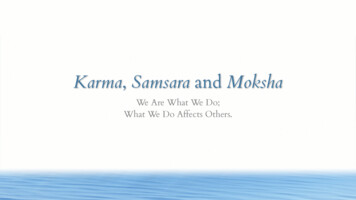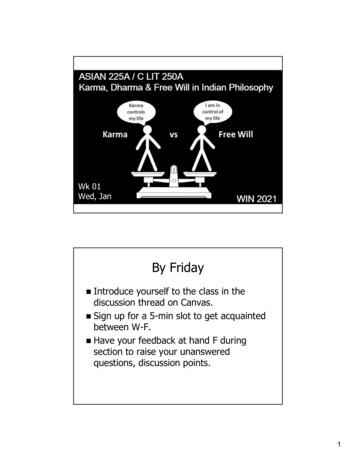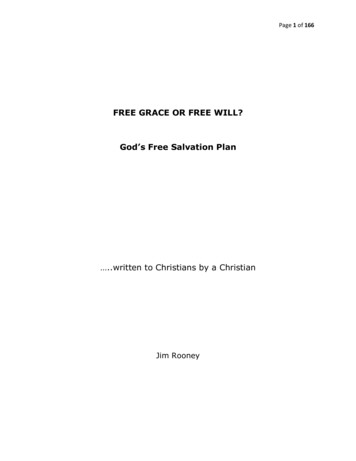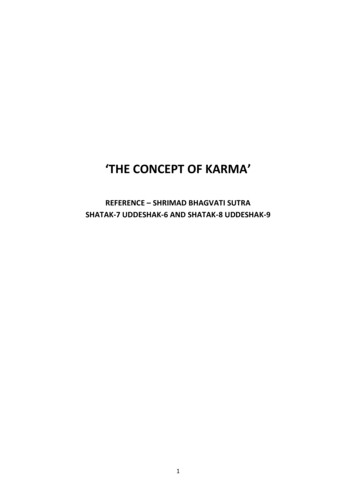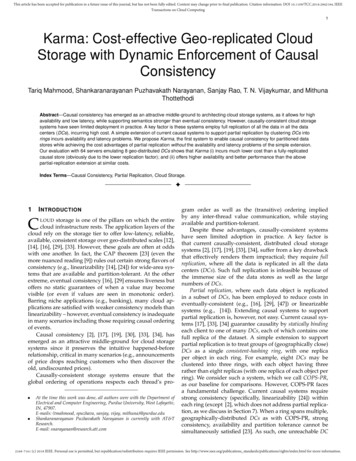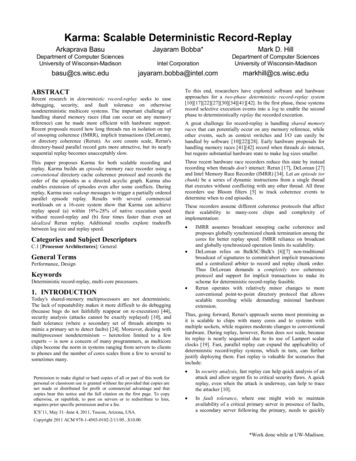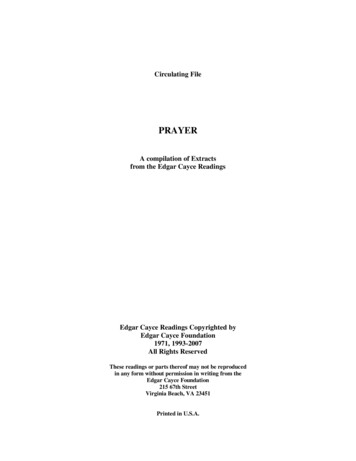
Transcription
From KarmatoGrace
From KarmatoGraceThe Power of the Fruits of the SpiritJohn Van AukenA.R.E. Press Virginia Beach Virginia
Copyright 2010by John Van Auken1st Printing, May 2010Printed in the U.S.A.All rights reserved. No part of this book may be reproduced or transmittedin any form or by any means, electronic or mechanical, includingphotocopying, recording, or by any information storage and retrievalsystem, without permission in writing from the publisher.A.R.E. Press215 67th StreetVirginia Beach, VA 23451-2061ISBN-13: 978-0-87604-495-7 (trade paper)Edgar Cayce Readings 1971, 1993-2007by the Edgar Cayce Foundation.All rights reserved.Cover design by Christine Fulcher
Contents1 Karma .12 Grace . 113 Fruits of the Spirit . 194 The Fruit of Love . 315 The Fruit of Forgiveness . 536 The Fruit of Mercy . 657 The Fruit of Patience . 758 The Fruit of Faith . 819 The Fruit of Meekness . 9110 The Fruit of Humility . 9911 The Fruit of Kindness . 10512 The Fruit of Gentleness . 10913 The Fruit of Peace . 11314 The Fruit of Joy . 12315 The Fruit of Goodness . 12916 The Fruit of Temperance . 13317 The Fruit of Long-Suffering . 13918 In the Spirit . 14319 God Speaks to Us . . . . 16120 Growing Together . 16721 Gifts of the Spirit . 17522 God: Trinity in One . 185
Karma11KarmaThe word karma originated in the ancient Indo-Aryan language ofSanskrit, which is the religious language of Hinduism and Buddhism. Itcomes from a root word that means “to do, to make.” The broader meaning of this term is that thoughts, spoken words, and physical actionscreate a response in both the macrocosm of the outer life and the microcosm of the inner life of an individual soul. Even the most privatethoughts, words, and actions generate a reaction as well as make animpression on an ethereal film of the collective consciousness, what isreferred to as the akasha in Hinduism, which is comparable to the Western concept of the “Book of Life” for each soul and, in metaphysicalcircles, often called the akashic record.Interestingly, when Edgar Cayce would enter a deep, meditativetrance to read the akashic record, he explained that thoughts were asreal as actions, so much so that he had to strain to determine whetherthe soul seeking the reading actually did something or just thought about1
2From Karma to Gracedoing it. In the greater scheme of life, especially soul life, thoughts areas real as actions. Here are two of Cayce’s readings on this matter:The Mind—which is of the earth earthy but of heaven heavenly,and divine—is the builder, and so the thoughts may becomecrimes or miracles depending upon how they are applied in theexperience of each soul in its sojourn through any period ofactivity in the earth. But, as has been intimated, know that thethought of a soul influences the sun, the moon, and all theheavenly hosts; for as you do unto the least of your brethren youdo it unto the Creator. O that men would learn, would becomeconscious, that as you think of those—even though they beguileyou, though they deride you, though they tamper with your ownpurpose—as you do unto them, you do it unto God. EC 315-4For mind is the builder and that which we think upon maybecome crimes or miracles. For thoughts are things and as theircurrents run through the environs of an entity’s experience thesebecome barriers or steppingstones.EC 906-3In Hinduism (originating approximately 7000 years ago, or millionsof years ago, according to the Ramayana), the word karma first appears inthe Rig Veda, the oldest portion of the Vedas, which are the religioustexts of Hinduism. Veda means “knowledge.” Rig Veda means “knowledge in verse” and is a collection of poetic hymns written some 3700 to3300 years ago. In the Rig Veda, karma means “religious sacrifice.” Curiously, there is no suggestion in the Rig Veda of its later meaning as areactive force affecting a soul’s character and circumstances. There issome indication of this in the Upanishads (another portion of the Vedas,written roughly 2800 to 2400 years ago). Here it is taught that actioncreates tendencies in a soul, which then produce further action, and asa result, further reaction, or karma. According to these teachings, thesoul’s subtle body (the “vehicle of consciousness”; sukshma sarira in Hinduism) carries the seeds of karma, and the physical body and world arethe fields in which the reaction is experienced. Hence more karma isalso created, which generates a recurring cycle of birth, death, and re-
Karma3birth for the soul. The soul becomes caught up in a cycle of action andreaction.Vedanta (another part of the Vedas) and Yoga (six distinct Hindu philosophies) speak of three kinds of karma: (1) karma to be experiencedduring the present lifetime, (2) the karma sown in the present life andreaped in a future life, and (3) latent karma, or the carry-over of karmato be experienced at some point when the stimulation is just right tobring it to the surface again. Liberation (moksha) is freedom from karma.When liberation is attained, the great storehouse of latent karma isburned up and present-life karma is resolved. The liberated soul createsno new karma and, at death, having no more karma, is no longer caughtin the wheel of birth, death, and rebirth.The idea that latent karma can be dissipated in the fire of enlightenment is fundamental to this book’s intention. The fire we are speakingof is that which cleanses consciousness, purges negative habits, andpurifies intentions. This is not only an Eastern but a Western teaching,also found in Western Scripture and teachings, as exemplified in thesequotations:Our God is a consuming fire.Hebrews 12:29I baptize you with water for repentance, but he who iscoming after me . . . he will baptize you with the HolySpirit and with fire.Matthew 3:10Fire is often a metaphor for the Spirit, especially the cleansing Spiritthat burns up karma and its reappearing influences, leaving one renewed and strong. In this book we will study the “Fruits of the Spirit,”which are those practices and dispositions that contain the seeds of theSpirit and, when enlivened through application in our daily lives andnurtured in our innermost being, ignite the cleansing Spirit. We willalso learn about the magical power of Grace and its role in our soulgrowth and mental enlightenment.Fundamental to the teaching of karma is the responsive nature of
4From Karma to Gracethought, word, and action. The motivating influence generatingthoughts, words, and actions creates a corresponding response. If theintention is in harmony with the Creative Forces, then so-called goodkarma results. If the intention is destructive or out of harmony with theuniversal life force and the ideal pattern for all life, then bad karmaresults.It is important to understand that the response is neutral; in otherwords, it is without passion. A simple universal law governs it: Whatever we do with our free will—in thought, word, or action—comes backupon us. The response is not motivated by retribution or punishmentbut by the Grace of the Divine to educate and enlighten. The law isintended to help the doer better grasp his or her effect upon self, others,and the whole of creation.We express our knowledge of this law when we say “what goesaround comes around” and “be careful what you wish for.” In our sacredScriptures we find: “An eye for an eye”; “As you sow, so shall you reap”;and “With what measure you measure, so shall it be measured to you.”These sayings articulate the law of karma. Even scientists observe thatfor every action there is an equal and opposite reaction.The law is unavoidable and immutable. Jesus taught that not one jotwill be erased from the law and warned that those who teach otherwiseare deceiving themselves and others. (Matthew 5:18)There is an old saying whose origin is lost in antiquity, but TryonEdwards, a theologian in the 1800s, republished it. It reveals the creativeprocess of rthoughts, for they become words.words, for they become actions.actions, for they become habits.habits, for they become character.character, for it becomes your destiny.We are what we have thought, spoken, and done. Our destiny is thekarma of our previous thoughts, words, and actions; but more thanthat, it is a habit pattern that we are building. And, as with most habits,it will be difficult to stop. Our motivations, expectations, and concerns
Karma5(even fears) shape our inner and outer reality. Fortunately, the law isever in effect, and therefore we can change our tomorrows and ourcharacter by engaging better thoughts, words, and actions today.Karma does not always result as an immediate response. It may liedormant within the heart and mind and on an etheric fabric of thecollective consciousness until some stimulant awakens it. Often this response comes in a future experience and new setting, possibly evenwith different souls from those with whom it originated, although it ismore likely that they are the same souls but with new personalities indifferent settings. The outer self often feels unfairly put upon, having nomemory of the origins of these responses, habits, and character traits.And although they are innate, the outer self rarely comprehends theirpresence, because karma belongs to the deeper self, the soul self. In onerespect, karma is deep memory, within both the individual and thecollective memory. Since the outer mind is often focused on currentsituations, it does not see the whole of soul life and soul karma—it liveson this side of a veil that separates inner consciousness from physicalconsciousness. In some ways this is a blessing because it removes theweight of guilt, fear, and self-condemnation. In other ways it is painfuland confusing because the outer self cannot understand why thesethings are happening and where its poor habits come from. But thelesson to be learned is not so much for the outer, earthly self but for theinner, eternal soul, and the soul learns through the senses of the outerself. Of course, if the outer and inner selves have made progress towardcooperation and reunion, then both may know and understand what isgoing on—and the veil that separates them becomes less opaque.When thinking of karma, it is important to realize that its influence isnot only in the deeper consciousness but also inside the physical body,in the “mind” of the body’s cells, tissues, and organs, or what is oftencalled “body memory.” The incarnating soul brings its karma with it anddistributes its influence throughout the body as it enters at birth intothe nervous systems (cerebrospinal and sympathetic-parasympathetic,which correspond to the Yogic sushumna and ida-pingala) and the endocrine glands (which correlate with the chakras and lotuses). The incarnating soul influences the genes of the physical body, turning oncertain genes while leaving others off, and this may change throughout
Karma 1 1 Karma 1 The word karma originated in the ancient Indo-Aryan language of Sanskrit, which is the religious language of Hinduism and Buddhis

